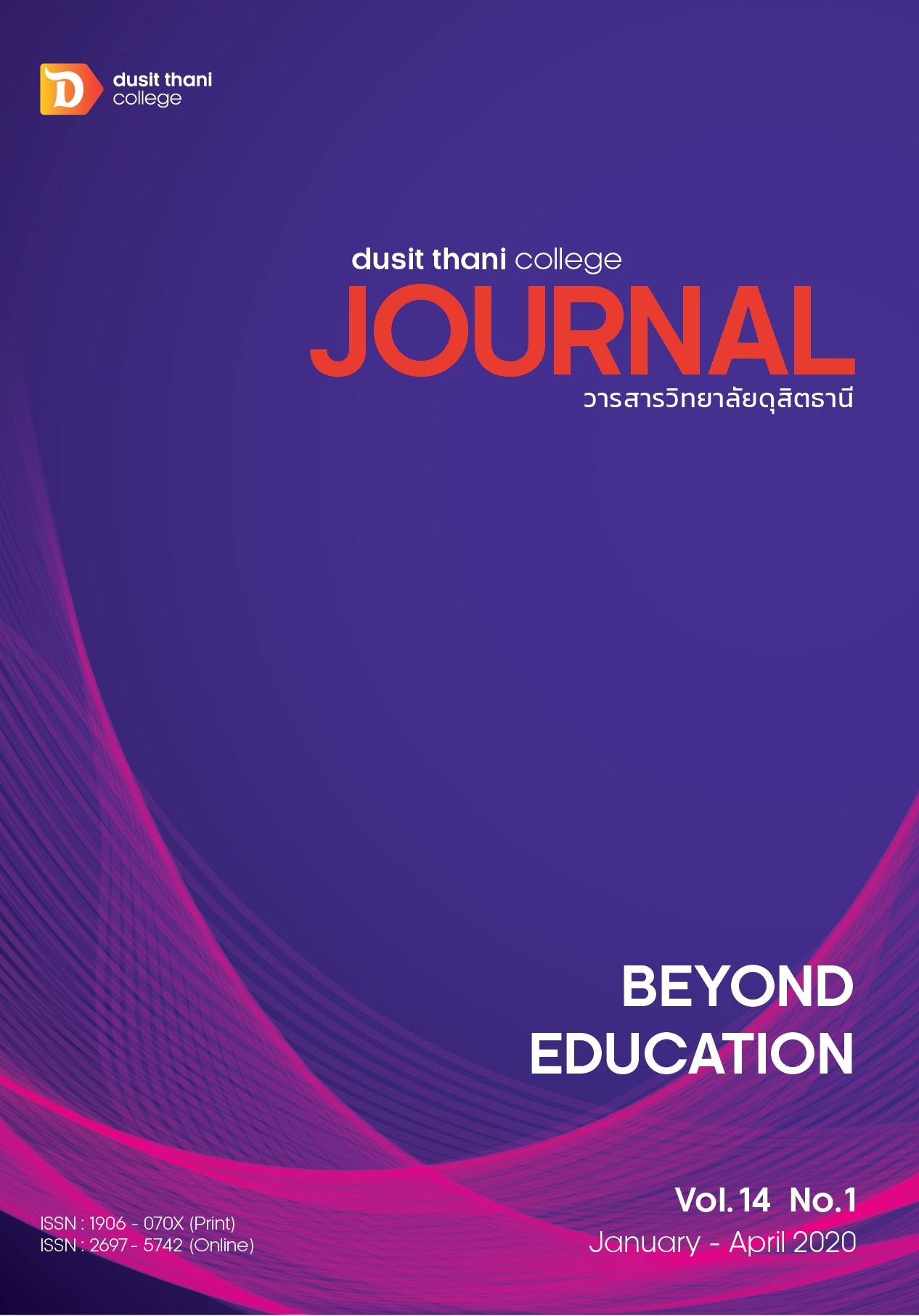The Adaptive Marketing Strategy Affecting Thai Food Original Value Perception
Main Article Content
Abstract
The research was aimed at studying general information involved with Thai original cuisine at present and adaptation of marketing strategy for value perception on Thai original cuisine. The questionnaires were constructed as a research tool for collecting data from 552Thai original cuisine restaurants. The statistics used for analysis were frequency distribution, percentage, mean and standard deviation.
The characteristics’ Thai original cuisine business information found that mostly were fast dining (56.2%) and casual dining (32.4%) respectively. The pattern of Thai original cuisine that mainly marketed was a la carte (52%), upcountry location (49.8%), not more than 15 employees (57.4%), operating business mostly 11-20 years time period (46.4%). The information perception on the Thai original cuisine mostly through internet (81.3%) and private persons such as relatives (51.3%), business alliances and others including business operation resulted at present compare with last year mostly marketing project at 52.4 percentage. The Thai original cuisine business shops had adaptive marketing strategy of Thai original cuisine on value perception of Thailand at merely high level (x̄=2.75). The perception of service value by customers’ was at high level (x̄=2.58) such as feeling happy in eating at this shop, the quality of service and food preparation with qualified good price respectively.
Article Details
Article Screening Policy
- All research and academic articles to be published must be considered and screened by three peer reviews in the relevant field / article.
- All articles, texts, illustrations and tables published in the journal are the personal opinions of the authors. Editors don't always have to agree. And no responsibility whatsoever is the sole responsibility of the author.
- The articles to be published must never be published. Where did you first publish? And not in the consideration of other journals If the audit found that there has been a duplicate publication It is the sole responsibility of the author.
- Any article that the reader sees as being plagiarized or impersonated without reference. Or mislead the work of the author Please let the journal editor know it will be your greatest blessing.
References
2. Cochran, W. G. (1977). Sampling techniques. (3rd ed). New York: John Wiley & Sons, 1 - 2.
3. Department of Business Development. (2018). Statistics of number of food business in Thailand 2017. [online] Retrieved from http://www.dbd.go.th/download/ document_file/Statisic/2560/T26/T26_201703.pdf. on 5 July 2018. (in Thai)
4. Food Institute. (2014). Course on Thai food store management . Bangkok: Kasetsart University.
5. Hoogland, J. J., and Boomsma, A. (1998). Robustness studies in covariance structure modeling: An overview and meta-analysis. Sociological Methods & Research, 26(3), 329 - 367.
6. Kanchanapa, Pawinee. (2011). Principles of marketing. Bangkok: Top, 257 - 260. (in Thai)
7. Kasikornthai Research Center. (2016). SME ready for new trend strategy for food store business after a half year.[online] Retrieved from https://www.kasikornbank. com/th/business/sme/.../article/.../SMELocalRestaurant.pdf. on 5 July 2018. (in Thai)
8. Khuharattanachai, Chujai. (1999). Introduction to Statistics. Bangkok: Department of Statistics, Mahanakorn Technical University, 7 - 10. (in Thai)
9. Limmanond, Phanu. (2007). Retail management strategy. Bangkok: Pariyas, 118 - 119. (in Thai)
10. Office of Business Information. (2017). Restaurant/ Food shop. Bangkok: Office of Business Information, Department of Business Development. (in Thai)
11. Panukanan, Chavanrat., Na Pathum, Siwarat, and Laksitamas, Prin. (2015). A model development of service marketing strategy for perceived value in Thai fusion food for AEC market. Panyapiwat Journal, 7(Special Issue August), 26 - 38. (in Thai)
12. Roig, J. C. F., Garcia, J. S., Tena, M. A. M., and Monzonis, J. L. (2006) Customer perceived value in banking services. International Journal of Bank Marketing, 24(5), 266 - 283.
13. Sawatburi, Oranong. (2012). Organization behavior and communication. Bangkok: Chulalongkorn Printing, 9 - 26. (in Thai)
14. Sereerut,Siriwan., Sereerat, Suporn., Meechinda, Panisa., Lertvannavith, Orathai., Laksitanond, Prin., Patanavanich, Oungart., and Arnuthchanond, Jirawat. (2009). Modern marketing management. Bangkok: Se-Ed, 262 - 263. (in Thai)
15. Sethabutr, Archima., and Wattanapanich, Saisawan. (2009). Marketing management. (13thed). Bangkok: Thammasart University, 24 - 28. (in Thai)
16. Sheth, J. N., Newman, B. I., and Gross, B. L. (1991).Consumption values and market choice. Cincinnati. South Western Publishing: Ohio, 18.
17. Taro, Y. (1973). Statistic: An introductory analysis. New York: Harper & Row, 1,089.
18. Thai Food Industry to the World Enterprise Network. (2017). Overview of Thai food industry to the world enterprise network. Bangkok, 12. (in Thai)
19. Thai Herbal Learning Center. (2017). Local Thai cuisine. [online] Retrieved from http://www.be7herb.wordpress.com/สุโขทัยธรรมธิราช/ธรรมานามัย/หน่วยที่-1-7/6-อาหารไทยพื้นบ้าน/. on 5 July 2018. (in Thai)
20. The Revenue Department. (2017). SMEs business. [online] Retrieved from http://www.rd.go.th/publish/38056.0.html. on 5 July 2018. (in Thai)
21. Tirakanan, Suvimol. (2007). Research methodology in social sciences: Practical guideline. Bangkok: Chulalongkorn Printing. (in Thai)
22. Tongkum, Malichan. (2014). Marketing principle. Mahasarakham: Apichart Printing Shop, 65 - 76. (in Thai)
23. Viratchai, Nongluk. (1999).The linear relationship (LISREL): Statistic for Social Science and Behavioral Sciences. Bangkok: Chulalongkorn University Printing, 32, 84. (in Thai)
24. Zeithaml, V. A. (1988). Consumer perceptions of price, quality, and value: A means-end model and synthesis of evidence. Journal of Marketing, 52(3), 2 - 22.


